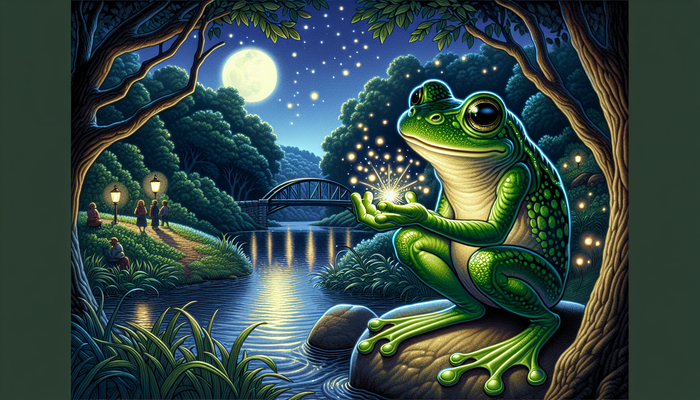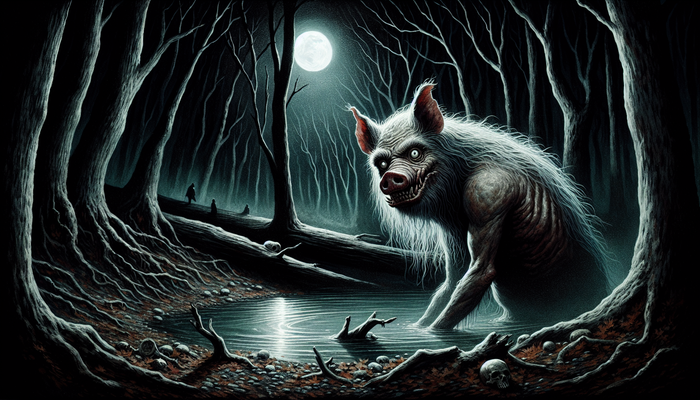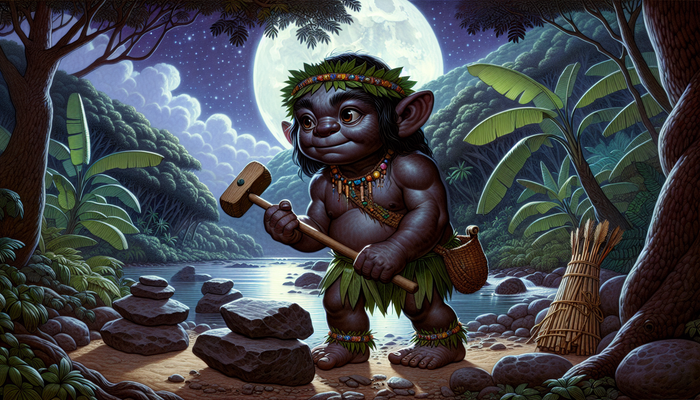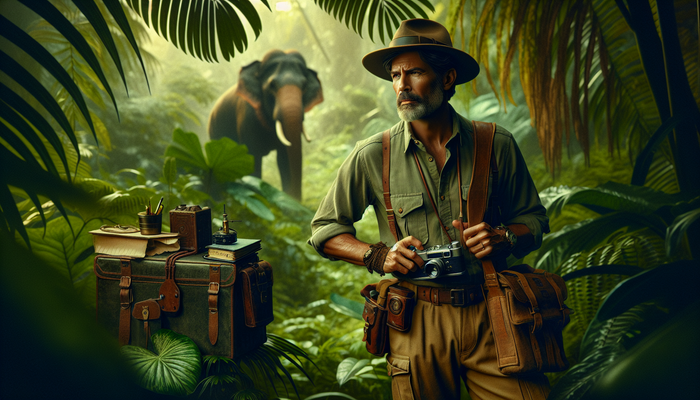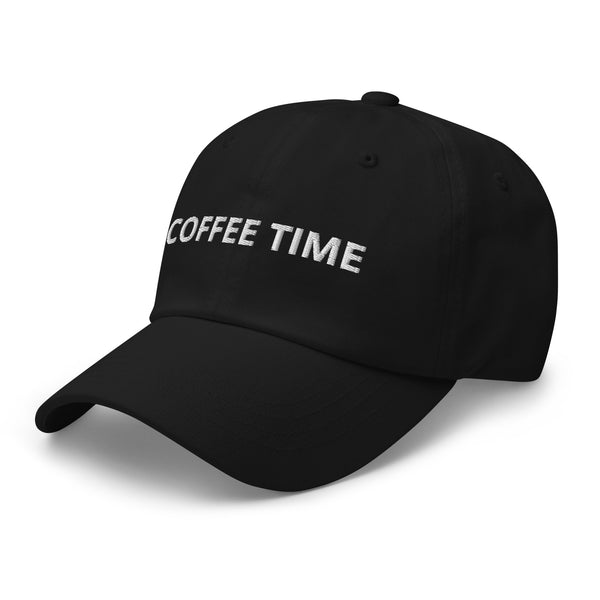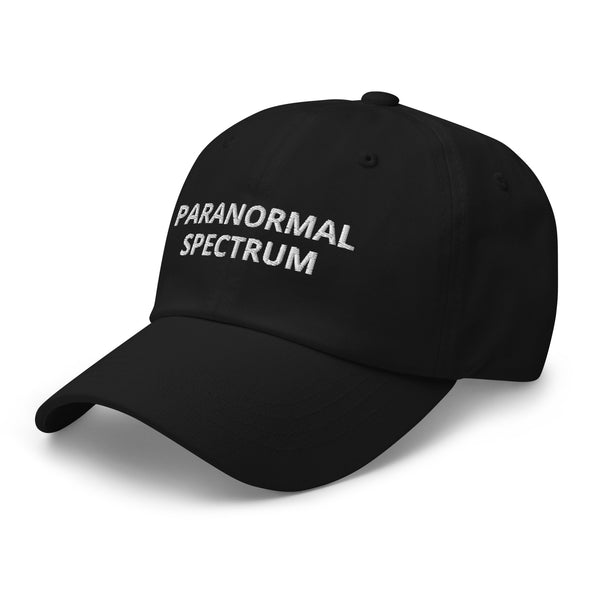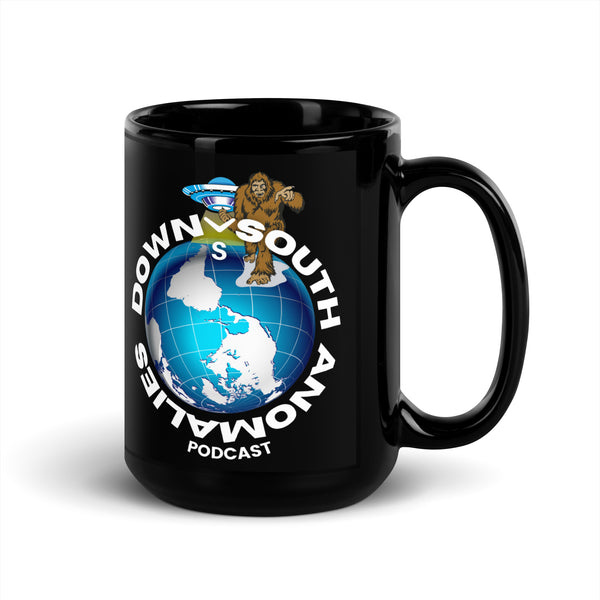Discover the Momo Creature: Missouri's Mysterious Monster
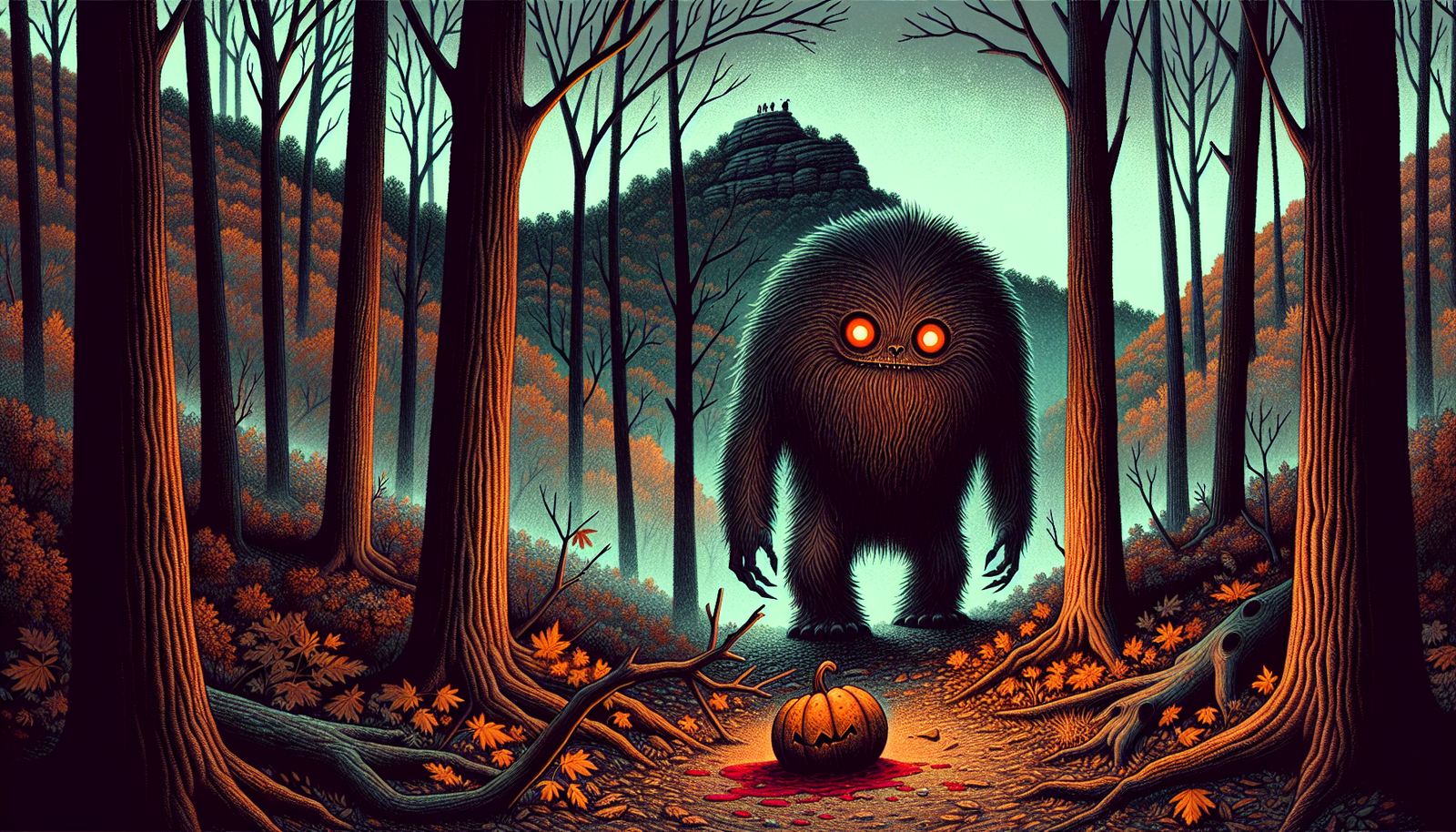
By Dr. Elizabeth Harper, Cryptozoologist
The Birth of a Legend
On July 11, 1972, the sleepy town of Louisiana, Missouri, nestled along the banks of the Mississippi River, became the epicenter of a cryptozoological sensation. The Harrison siblings—Terry, 8, Wally, 5, and their older sister Doris, 15—were about to have an encounter that would change their lives and put their hometown on the map.
It was a typical summer afternoon when Terry and Wally were playing in their backyard at the foot of Marzolf Hill. Suddenly, their playful laughter turned to screams of terror. Doris, who was inside the house, rushed to the bathroom window to investigate. What she saw would become the stuff of legend.
There, standing by a tree, was a creature unlike anything she had ever seen. It stood about 7 feet tall, covered in dark, matted fur. Its most striking feature was its head—large and round, like a pumpkin. But it was the eyes that truly terrified Doris: glowing orbs of orange that seemed to pierce right through her.
The creature wasn't just standing there. In its arms, it clutched what appeared to be a dead dog, blood matting its fur. The stench that accompanied the beast was overwhelming, a putrid odor that would become one of Momo's calling cards in future sightings.
Doris, overcome with fear, began to cry. She ran to call her mother, setting in motion a chain of events that would transform Louisiana from a quiet river town into the monster capital of the Midwest.
The Summer of Momo: A Town Gripped by Fear
News of the Harrison children's sighting spread through Louisiana like wildfire. Within days, the local media had picked up the story, dubbing the creature "Momo"—short for "Missouri Monster." The name stuck, and soon Momo was making headlines across the state and beyond.
As July wore on, more sightings were reported. Ellis Minor, a resident living on the Great River Road, had his own terrifying encounter. Sitting on his porch late one evening, Minor's bird dog began to growl. When he shone his flashlight towards the road, there stood Momo, its coal-black fur unmistakable in the beam of light. "As soon as I threw the light on it," Minor later recounted, "it whirled and took off thataway."
The frequency of sightings and the credibility of the witnesses—many of whom were respected members of the community—led to the formation of search parties. Police Chief Shelby Ward organized a posse of 20 men to comb the woods around Marzolf Hill. Armed with rifles and determination, they scoured the area for any sign of the creature.
Despite their efforts, no concrete evidence was found. No footprints, no fur, no physical trace of Momo's existence. But the lack of evidence did little to quell the growing hysteria. If anything, it added to the mystery, fueling speculation and drawing curious onlookers from far and wide.
The media frenzy reached a fever pitch. Reporters from national news outlets descended on Louisiana, their cameras and notepads at the ready. Local newspapers ran daily updates on the latest sightings and theories. Television crews set up camp, hoping to catch a glimpse of the elusive beast.
For the residents of Louisiana, life had taken on a surreal quality. Children were kept indoors after dark. Adults traveled in groups, wary of every shadow and rustling bush. The town had become a character in its own real-life monster movie, with Momo as the star.
Eyewitness Accounts: Piecing Together the Momo Puzzle
As the summer progressed, a clearer picture of Momo began to emerge from the various eyewitness accounts. While details varied, certain characteristics remained consistent across sightings.
Richard Alan Murray, a respected member of the community who had served as the town's fire chief and sat on the city council, provided one of the most compelling accounts. Murray was driving near the Town Branch, a small creek running through Louisiana, when he spotted movement in the woods. As he turned his headlights towards the hill, they illuminated a figure that defied explanation.
"I was amazed to see something," Murray later said. "I thought it was a bunch of nonsense, but then I saw something." He described a large, upright creature covered in brown hair. When the beast realized it had been spotted, it quickly disappeared over the hill.
Other witnesses reported similar features: the creature's immense size, its ability to move quickly despite its bulk, and the ever-present foul odor. Some claimed to have heard strange vocalizations—deep, guttural growls unlike any known animal in the area.
The consistency of these reports lent credibility to the Momo phenomenon. These weren't just random sightings by excitable individuals. These were detailed accounts from level-headed members of the community, many of whom had initially been skeptical of the Momo stories.
The psychological impact of these encounters cannot be overstated. Fear and excitement can alter perception, potentially exaggerating or distorting details. But the sincerity of the witnesses, coupled with the physical reactions many experienced—racing hearts, cold sweats, the instinctive urge to flee—suggested that something truly unusual was occurring in Louisiana that summer.
As the sightings continued, patterns began to emerge. Momo seemed to prefer wooded areas, particularly around Marzolf Hill and along the Mississippi River. It was most active in the evening and early night hours. And while it showed aggression towards animals—as evidenced by the dead dog in the initial sighting—it seemed to avoid direct confrontation with humans, often fleeing when spotted.
These details painted a picture of a creature that, while terrifying, wasn't actively hostile towards humans. This didn't make Momo any less frightening to the residents of Louisiana, but it did add another layer of mystery to the creature's nature and origins.
Momo in the Cultural Imagination
As the summer of 1972 faded into autumn, the Momo sightings became less frequent. But the creature's impact on the cultural landscape of Missouri—and indeed, the entire country—was just beginning.
Local musician Bill Whyte saw an opportunity in the Momo phenomenon. He penned a catchy tune titled "Momo the Missouri Monster," which quickly became a regional hit. The song's humorous lyrics recounted the creature's exploits and the town's reaction, helping to transform Momo from a source of terror into a kind of local mascot.
"Some said it was a monster, some said it was a bear," Whyte crooned, "but most of us could tell by the horrible smell that Momo had just been there." The song's popularity ensured that even as the initial panic subsided, Momo remained firmly entrenched in the public consciousness.
The tourism industry in Louisiana also got a boost from the Momo craze. Curious visitors flocked to the town, hoping to catch a glimpse of the famous monster. Local businesses capitalized on the influx, selling Momo-themed souvenirs and offering tours of the creature's supposed haunts.
Even major attractions got in on the act. Six Flags St. Louis, located about 80 miles south of Louisiana, introduced a ride called "Momo the Monster" in 1973. The attraction, which operated until 1994, featured a giant, furry creature that bore little resemblance to the descriptions of Momo but nonetheless kept the legend alive for a new generation.
Momo's influence extended beyond mere entertainment. The creature became a symbol of Louisiana's identity, a shared experience that bound the community together. Annual Momo festivals and celebrations became a tradition, allowing residents to commemorate the summer that put their town on the map.
The legend of Momo also inspired serious academic interest. Cryptozoologists—researchers who study animals whose existence is unproven—flocked to Louisiana to investigate. They conducted interviews, analyzed supposed evidence, and developed theories about Momo's nature and origins.
One such researcher was Loren Coleman, a renowned cryptozoologist who has written extensively on Momo and similar creatures. Coleman's work helped to place Momo within the broader context of cryptid sightings across North America, drawing parallels with other legendary beasts like Bigfoot and the Fouke Monster of Arkansas.
The cultural impact of Momo reached its zenith in 2019 with the release of "Momo: The Missouri Monster," a documentary film directed by Seth Breedlove. The film took an innovative approach, blending dramatized reenactments of the 1972 events with real interviews from witnesses and local historians.
Breedlove's film not only rekindled interest in the Momo legend but also showcased how deeply the creature had become embedded in the folklore of Missouri. It presented Momo not just as a monster story, but as a lens through which to examine small-town America, the power of shared narratives, and the human fascination with the unknown.
Theories and Explanations: Unraveling the Momo Mystery
As with any cryptid sighting, the Momo phenomenon has attracted its fair share of theories and explanations. These range from the mundane to the fantastic, each attempting to make sense of the bizarre events that unfolded in the summer of 1972.
Misidentification Theory
One of the most straightforward explanations is misidentification. Skeptics argue that Momo sightings can be attributed to known animals, most likely black bears. Missouri does have a black bear population, and a large bear standing on its hind legs could potentially be mistaken for a humanoid creature, especially in low light conditions or by frightened observers.
However, this theory fails to account for some of Momo's more unusual characteristics, such as its pumpkin-shaped head and glowing eyes. It also doesn't explain the creature's apparent bipedal nature or its reported size, which exceeded that of typical black bears.
Hoax Theory
Another popular theory is that Momo was an elaborate hoax. Some suggest that pranksters, inspired by Bigfoot stories, may have donned costumes to frighten locals and tourists. While this could explain some sightings, it struggles to account for the sheer number and consistency of reports, as well as the credibility of many witnesses.
Exotic Theories
More exotic theories have also been proposed. Some cryptozoologists speculate that Momo could be a surviving population of Gigantopithecus, an extinct genus of ape that lived in Asia until about 100,000 years ago. While intriguing, this theory lacks any solid evidence and fails to explain how such a creature could have remained undetected in Missouri for so long.
Others have suggested extraterrestrial or interdimensional origins for Momo, pointing to the reports of strange lights in the sky that accompanied some sightings. These theories, while popular among some UFO enthusiasts, are generally dismissed by more mainstream researchers due to their highly speculative nature.
Psychological and Sociological Factors
A more nuanced approach to understanding the Momo phenomenon comes from examining the psychological and sociological factors at play. Mass hysteria, also known as mass psychogenic illness, has been proposed as an explanation for the wave of sightings.
This theory suggests that the initial sighting by the Harrison children, amplified by media coverage and the suggestible nature of human memory, could have led to a kind of collective delusion. People, primed to see a monster, may have misinterpreted ordinary stimuli or experiences through the lens of the Momo narrative.
While this explanation can account for some aspects of the Momo phenomenon, it doesn't fully explain the physical evidence reported by some witnesses, such as unusual tracks or the persistent foul odor associated with the creature.
A Multifaceted Explanation
Perhaps the most compelling explanation is that the truth of Momo lies somewhere between these various theories. The initial sightings may have been triggered by a real, albeit misidentified, animal encounter. This, combined with the power of suggestion, media sensationalism, and the human tendency to elaborate on stories over time, could have given rise to the full-fledged Momo legend.
Regardless of its origins, the Momo phenomenon reveals much about human nature and our relationship with the unknown. It demonstrates our capacity for wonder, our desire to believe in something beyond the ordinary, and the power of shared narratives in shaping community identity.
The Momo Challenge: A Modern Twist on an Old Tale
In a strange twist of fate, the name "Momo" resurfaced in popular culture in 2018, this time associated with a very different kind of monster. The "Momo Challenge" was an alleged online phenomenon that sparked widespread panic among parents and educators.
According to the stories circulating on social media and in news reports, the Momo Challenge involved a creepy character named Momo contacting children through WhatsApp and other platforms. This Momo, represented by an unsettling image of a sculpture with bulging eyes and a wide, disturbing grin, supposedly encouraged children to perform increasingly dangerous tasks, culminating in self-harm or suicide.
The image used for this new Momo was actually a photograph of a sculpture called "Mother Bird," created by Japanese artist Keisuke Aisawa for a special effects company. The sculpture, with its eerily human face and bird-like body, had nothing to do with the original Momo of Missouri or any online challenge.
As the panic spread, schools issued warnings, police departments released statements, and concerned parents shared frantic posts on social media. The story gained such traction that even celebrities like Kim Kardashian shared warnings about the challenge to their millions of followers.
However, as quickly as the panic arose, it began to unravel. Fact-checkers and internet safety experts found no credible evidence that the Momo Challenge was real. There were no confirmed cases of children being harmed as a result of the challenge, and no proof that the challenge existed beyond rumor and speculation.
The Momo Challenge turned out to be a textbook example of a moral panic—a widespread fear, often irrational, that some evil threatens the well-being of society. It was a hoax that preyed on parental fears about online safety and the hidden dangers of the digital world.
While the Momo Challenge had no connection to the original Momo of Missouri folklore, the two phenomena share interesting parallels. Both tapped into deep-seated fears—one about the unknown lurking in the woods, the other about the unseen threats in the digital realm. Both spread rapidly through a combination of media coverage and word-of-mouth. And both revealed our collective susceptibility to captivating, albeit unverified, stories.
The Momo Challenge hoax serves as a modern counterpoint to the original Momo legend, illustrating how urban legends and moral panics have evolved in the digital age. Where the Missouri Momo sparked local hysteria and drew curious tourists, the Momo Challenge spread globally within days, fueled by the rapid-fire sharing capabilities of social media.
This modern incarnation of Momo also highlights the enduring power of monster stories to capture our imagination and reflect our deepest fears. In 1972, those fears centered on the unknown dangers lurking in the natural world. In 2018, they focused on the perceived threats of technology and the internet.
The quick debunking of the Momo Challenge also stands in contrast to the enduring mystery of the original Momo. While modern fact-checking tools and widespread internet access allowed for rapid investigation and dismissal of the online hoax, the true nature of the Missouri Monster remains a subject of debate and speculation nearly five decades later.
Momo's Legacy: From Local Legend to Cultural Phenomenon
Today, nearly 50 years after that fateful summer, Momo continues to cast a long shadow over the cultural landscape of Missouri and beyond. The creature has transcended its origins as a local monster sighting to become a multifaceted cultural icon, inspiring everything from academic studies to horror films.
In Louisiana, Missouri, Momo remains a point of pride and fascination. The town has embraced its cryptid heritage, hosting Momo-themed events and celebrating the creature's role in putting Louisiana on the map. Local businesses still capitalize on the Momo brand, selling t-shirts, postcards, and other memorabilia to tourists drawn by the legend.
The Momo story has also become a valuable tool for teaching local history. Schools in the area often incorporate the Momo legend into their curriculum, using it as a springboard to discuss topics like critical thinking, media literacy, and the nature of folklore.
In the broader world of cryptozoology, Momo occupies a special place. While not as famous as Bigfoot or the Loch Ness Monster, Momo is often cited as one of the most well-documented cryptid sightings of the 20th century. The creature is frequently mentioned in books and documentaries about mysterious beasts, held up as an example of how a local legend can capture the national imagination.
Momo has also left its mark on popular culture. Beyond the song and theme park ride of the 1970s, the creature has inspired numerous works of fiction. Authors have penned Momo-centric novels and short stories, while filmmakers have used the legend as the basis for horror movies and documentaries.
The 2019 film "Momo: The Missouri Monster" represents perhaps the most significant exploration of the Momo legend in recent years. Director Seth Breedlove's innovative approach, blending documentary techniques with dramatic reenactments, brought the story to life for a new generation. The film not only recounted the events of 1972 but also examined the lasting impact of the Momo phenomenon on the town of Louisiana and its residents.
In the world of paranormal investigation, Momo sightings continue to be reported sporadically. While none have matched the intensity or frequency of the 1972 flap, these modern sightings keep the legend alive and provide fodder for ongoing research and speculation.
The enduring fascination with Momo speaks to something fundamental in human nature—our attraction to mystery and our desire to believe in something beyond the ordinary. Whether seen as a flesh-and-blood creature, a supernatural entity, or a product of mass hysteria, Momo represents the unknown, the unexplained, the possibility that there's more to our world than meets the eye.
Moreover, the Momo legend serves as a reminder of the power of storytelling. It demonstrates how a single event, amplified by media coverage and word-of-mouth, can take on a life of its own, shaping the identity of a community and capturing the imagination of an entire nation.
As we look to the future, it's clear that Momo's story is far from over. New generations continue to discover the legend, bringing fresh perspectives and interpretations. Advances in technology may someday shed new light on the events of 1972, either supporting or debunking the Momo sightings. Or perhaps the creature itself will reemerge, reminding us that there are still mysteries to be solved and wonders to be discovered in the woods of Missouri.
Whatever the future holds, one thing is certain: Momo, the Missouri Monster, has secured its place in the pantheon of American folklore. It stands as a testament to our enduring fascination with the unknown, a reminder of the power of shared stories, and a symbol of a small town's brush with the extraordinary. In the end, whether Momo was real or imagined may be less important than the impact it has had on our collective imagination and the way it continues to inspire wonder, fear, and curiosity in all who hear its tale.
From Bigfoot to UFOs: Hangar 1 Publishing Has You Covered!
Explore Untold Stories: Venture into the world of UFOs, cryptids, Bigfoot, and beyond. Every story is a journey into the extraordinary.
Immersive Book Technology: Experience real videos, sights, and sounds within our books. Its not just reading; its an adventure.


